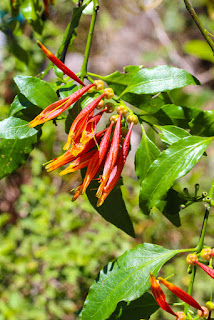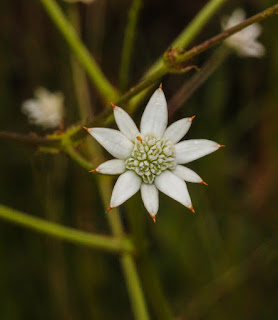Impatiens
flanaganiae BALSAMINACEAE [Vulnerable]
A rare tuberous species may be
known as Giant Pink busy lizzy or Mrs Flanagan’s impatiens. It is known from a
few localities near Port St. Johns, Eastern Cape, South Africa. It can also be
found in less well-known locations in central southern KwaZulu-Natal, such as Pondoland and southern
KwaZulu-Natal, growing in shade, usually on boulders on steep slopes or near
the base of waterfalls, mostly on sandstone.
It is threatened by harvesting for medicinal use, alien plant invasion and
water extraction from river systems.
It is a soft perennial herb that forms tubers to enable it to go dormant during dry season. It grows up to 1 m tall, in colonies. Tubers can grow to 6 inches long. Stems
are fleshy,
upright, branched, reddish, dying back in winter. Leaves large, longer than broad, gradually narrowing to a tip, margins toothed, stalks 10–45 mm. Flowers with side petals, rosy pink
with yellow markings inside. It flowers from November to January. The flowers make their appearance in the summer and autumn along the tops
of the stems. It is reported that under conditions of excessive heat the plant continues
to grow but flowers abort.
References:
Pooley, E.
1998. A field guide to wildflowers KwaZulu-Natal and the eastern region. Natal
Flora Publications Trust, Durban.
Von Staden, L., Victor, J.E. & Cloete, E. 2006.
Impatiens flanaganiae Hemsl. National Assessment: Red List of South African
Plants version 2015.1. Accessed on 2015/10/22
Impatiens
flanaganiae [online].
Available from: http://www.pacificbulbsociety.org/pbswiki/index.php/Impatiens
[Accessed on 2015/10/27]
Scott-Shaw, C.R. 1999. Rare and threatened plants of KwaZulu-Natal
and neighbouring regions. KwaZulu-Natal Nature Conservation Service,
Pietermaritzburg.
-----------------------------------------------------------------------------------------------------------------------
Argyrolobium longifolium FABACEAE [Vulnerable]
Twiggy subshrub, up to 1.5 m tall, upright, sparingly branched below.
Distributed around Pietermaritzburg to Tugela and Port
Shepstone, growing in sandstone grassland. The species is quite likely also more common in suitable sandstone
grasslands elsewhere within southern KwaZulu-Natal. Leaf surface smooth; sparsely silky, with closely-lying soft straight hairs
and shiny silky sheen at the lower surface of the leaf. Inflorescence almost directed to the same side, up to 20-flowered.
It flowers from September to February. Calyx
(outer-most whorl of floral organs) are silky with closely
appressed soft straight hairs and shiny silky sheen, deeply two-lipped, upper
lip incipiently double toothed, 9−12 mm long, lower lip 10−14 mm long. Corolla lemon yellow, becoming black
in drying plants. Fruits are
linear, flattened between seeds.
 |
| Argyrolobium longifolium (Photo Alison Young) |
 |
| Argyrolobium longifolium (Photo Alison Young) |
If you have seen this plant, please
contact Mbali Mkhize, CREW programme: KZN Node Project Assistant m.mkhize@botanicalsociety.org.za
References:
Edwards,
T.J. 1994. South African Journal of Botany 60(1): 39−43.
Edwards, T.J., Raimondo, D. & von Staden, L. 2014.
Argyrolobium longifolium (Meisn.) Walp. National Assessment: Red List of South
African Plants version 2015.1. Accessed on 2015/10/22
|



















































































